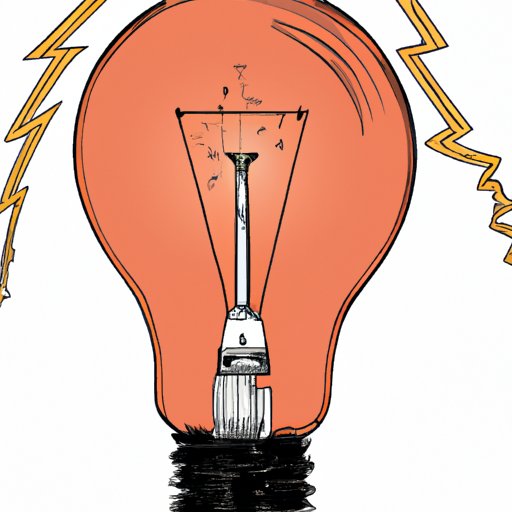Introduction
The invention of the lightbulb is one of the most important inventions in human history. It changed the way we live and work, revolutionizing home and business lighting and enabling new forms of communication. But who was the inventor of the lightbulb? And what challenges did they face in creating this revolutionary piece of technology? This article explores the legacy of Thomas Edison, the inventor of the lightbulb, looking at his background and education, his invention process, and the impact of the lightbulb on society.
A Biographical Overview of the Inventor of the Lightbulb
Thomas Alva Edison (1847-1931) was an American inventor and businessman. He is best known for inventing the lightbulb, but he also created the phonograph, the motion picture camera, and other groundbreaking technologies. Edison was born in Ohio and received little formal education, dropping out of school at age 12. Despite this, he was a prolific inventor and held 1,093 patents by the time of his death.
Edison began experimenting with electricity as a child and eventually set up his own laboratory in Menlo Park, New Jersey, where he conducted experiments and developed inventions. His first major success was the development of the phonograph in 1877, which revolutionized music recording. However, it was his invention of the lightbulb that made him famous and cemented his legacy.

Examining the History and Development of the Lightbulb
Before Edison’s invention of the lightbulb, lighting was mostly provided by candles, oil lamps, and gas lighting. These methods were inefficient and dangerous, and their use often caused fires. Edison spent several years researching and developing a better lighting system, and in 1879 he finally succeeded in inventing the first practical incandescent lightbulb.
The lightbulb was not invented overnight. Edison and his team had to overcome many technical difficulties in designing and building a lightbulb that could be mass produced and used in homes and businesses. They experimented with different materials and designs until they found the perfect combination of heat resistance, durability, and efficiency. They also had to overcome financial and legal obstacles in order to patent and market their invention.
Once Edison and his team perfected the lightbulb, they quickly realized its potential. They began manufacturing and selling the bulbs, and soon cities around the world were lit up with electric lights. Over the years, the design of the lightbulb has changed significantly, becoming more efficient and environmentally friendly. Today, LED bulbs are the most popular type of lightbulb, thanks to their long life span and energy efficiency.

The Impact of the Lightbulb on Society
The invention of the lightbulb revolutionized home and business lighting. Before the lightbulb, people had to rely on candles and oil lamps for light, which were inefficient and dangerous. With the invention of the lightbulb, people could now have access to bright, reliable light whenever they wanted. This enabled them to work and study late into the night, increasing productivity and knowledge.
The lightbulb also changed social habits and practices. People no longer had to retire early due to lack of light, and they could stay up late socializing or enjoying leisure activities. The lightbulb also enabled new forms of communication, such as radio and television, which allowed people to stay connected with each other despite being geographically separated.

Exploring the Legacy of the First Lightbulb Inventor
Thomas Edison was remembered as a genius inventor and entrepreneur. He was celebrated for his innovation and creativity, and for his pioneering spirit. His work has been recognized and honored in numerous ways, including monuments, awards, and buildings named after him. He is also remembered for his philanthropy, having donated millions of dollars to charitable causes throughout his lifetime.
Edison’s legacy lives on in the form of the lightbulb. To this day, the lightbulb is still one of the most widely used pieces of technology, and it continues to have a major impact on our lives. The lightbulb is a symbol of progress and innovation, and a reminder of the power of human ingenuity.
The Challenges Faced by the Inventor of the Lightbulb
Despite his success, Edison faced many challenges in inventing the lightbulb. He and his team had to overcome technical difficulties in designing and building a lightbulb that could be mass produced and used in homes and businesses. They also had to overcome financial and legal obstacles in order to patent and market their invention. Finally, they had to contend with social stigmas and misconceptions about electricity and its potential dangers.
Despite these challenges, Edison was able to create a revolutionary piece of technology that changed the world. His invention of the lightbulb illuminated the darkness and opened up a world of new possibilities.
Conclusion
The invention of the lightbulb was a turning point in human history. Thomas Edison was the inventor of the lightbulb, and his legacy lives on in the form of this revolutionary piece of technology. The lightbulb changed the way we live and work, revolutionizing home and business lighting and enabling new forms of communication. Edison overcame many challenges in inventing the lightbulb, and his legacy is a testament to the power of human ingenuity.
(Note: Is this article not meeting your expectations? Do you have knowledge or insights to share? Unlock new opportunities and expand your reach by joining our authors team. Click Registration to join us and share your expertise with our readers.)
